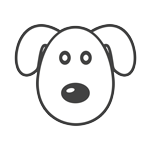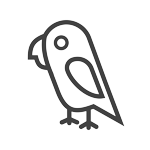
Why Puppies Chew and How to Handle It
If you've recently welcomed a puppy into your home, you've likely noticed a few things going missing—or rather, turning up with bite marks! Chewing is a natural and common behaviour in puppies, often causing frustration for new pet parents. Understanding why puppies chew and learning how to manage this behaviour can make the journey of raising your furry friend much smoother.
In this blog, we'll explore the reasons behind a puppy's chewing habit, how long this phase typically lasts, and practical strategies for redirecting it. We'll also address common concerns, like a puppy chewing their feet and tail, and provide actionable tips to help you and your puppy get through this teething stage with minimal stress.
Why Do Puppies Chew?
Chewing is an essential part of a puppy's development. It’s not just a random habit—there are several key reasons behind this behaviour:
Teething Pain Relief:
Just like human babies, puppies experience discomfort when their new teeth come in. Chewing helps to relieve the pain and pressure on their gums. During the teething phase, which typically begins around three weeks of age and can last until they are six months old, puppies will chew on almost anything they can find to soothe their gums.
Exploration and Learning:
Puppies are curious by nature, and since they don’t have hands, they use their mouths to explore the world around them. Chewing is one way they learn about different textures, tastes, and the durability of objects. This is why it’s crucial to provide them with safe and appropriate chew toys that cater to their exploratory needs.
Natural Instincts:
Chewing is also rooted in a dog's instinctive behaviour. In the wild, chewing helps keep a dog's teeth clean and their jaws strong. For domestic puppies, this instinct remains, even though they no longer need to hunt or break bones. Providing your puppy with durable dog toys can satisfy this natural urge and prevent them from targeting your furniture.
How Long Do Puppies Bite and Chew?
The chewing phase can vary in duration depending on the breed and individual puppy. However, the most intense period typically occurs during the teething phase, between three weeks and six months of age. During this time, your puppy’s baby teeth are falling out, and their adult teeth are coming in. This process is uncomfortable, and chewing is the puppy’s way of coping with the pain.
For most puppies, the urge to chew decreases as they finish teething and mature. However, some dogs may continue to chew out of habit or boredom if they aren’t provided with enough mental and physical stimulation. Ensuring your puppy has a variety of engaging dog toys can help manage this behaviour long-term.
What are the Common Chewing Issues
While chewing is normal, certain behaviours may indicate a problem or require extra attention:
Puppy Chewing Feet and Tail:
It's not uncommon for puppies to chew on their feet or tail. However, excessive chewing in these areas can signal issues like allergies, anxiety, or boredom. If your puppy is persistently chewing on their feet or tail, it’s important to monitor for other symptoms, such as redness, swelling, or limping, and consult your vet if necessary.
Destructive Chewing:
Destructive chewing, such as targeting furniture, shoes, or other household items, often occurs when puppies are left alone for too long or don’t have enough toys to keep them occupied. To prevent this, ensure your puppy has access to a variety of chew toys and a comfortable space to rest, like a cosy dog bed. You can also use a cooling mat, especially during warmer months, to provide them with a cool spot to relax, which may reduce the urge to chew out of discomfort.
How to Stop a Puppy from Biting and Chewing
Managing and redirecting your puppy's chewing behaviour is key to preventing it from becoming destructive. Here are some effective strategies:
Provide Appropriate Chew Toys:
One of the best ways to manage your puppy's chewing is to offer a selection of appropriate chew toys. Choose toys that are designed for teething puppies, made from durable materials, and that cater to different chewing styles. Rotate the toys to keep your puppy interested and avoid them getting bored with the same ones.
Create a Chew-Friendly Environment:
Puppy-proof your home by removing tempting items like shoes, books, and electrical cords from your puppy's reach. When you’re not able to supervise your puppy, confine them to a safe area with their dog toys and a comfortable dog bed. This will prevent them from getting into trouble and teach them to associate their space with positive experiences.
Use Positive Reinforcement Techniques:
When you catch your puppy chewing on something they shouldn't, calmly redirect them to a chew toy. Praise and reward them when they chew on the appropriate item. Over time, this will help them learn what is acceptable to chew on and what is not.
Offer Plenty of Physical and Mental Stimulation:
A tired puppy is less likely to chew out of boredom. Ensure your puppy gets plenty of physical exercise and mental stimulation through playtime, training sessions, and interactive toys. This will help expend their energy and reduce the likelihood of destructive chewing.
When to Seek Professional Help
If your puppy’s chewing behaviour is persistent, particularly if they’re consistently targeting their feet or tail, or if their chewing becomes destructive despite your efforts, it may be time to seek professional help. A veterinarian or a certified dog trainer can provide insights into the root cause of the behaviour and suggest tailored strategies to address it.
Chewing is a natural part of a puppy’s development, but it doesn’t have to be a source of frustration. By understanding why puppies chew and implementing the strategies outlined in this blog, you can help your puppy navigate this phase with minimal damage to your belongings. Remember, with patience and the right approach, most puppies will outgrow their chewing habits.
If you’ve found these tips helpful, don’t forget to share your own experiences with puppy chewing in the comments below! And be sure to subscribe to our blog for more insights on puppy care.










Leave a comment